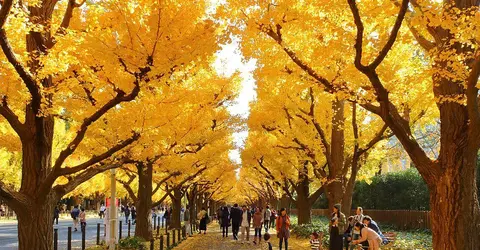Ginkgo: the sacred tree with golden leaves

Ginkgo, the tree of golden colors
Flick/ vicjuan
The Ginkgo biloba, a veritable living fossil, is an exceptional tree that has fascinated people for thousands of years. Native to China, this majestic tree with its golden fan-shaped leaves symbolizes longevity and resistance. Revered in Asian temples, it has conquered the world for its ornamental and medicinal qualities. Let's discover together the fascinating history, unique characteristics and multiple virtues of this golden-leaved sacred tree, a living witness to millions of years of evolution.
History and characteristics of Ginkgo biloba
Ginkgo biloba is a true survivor of history. Appearing over 270 million years ago, it is considered the world's oldest tree species. Despite climatic upheavals and the extinction of the dinosaurs, the Ginkgo has endured, surviving only in a few mild-climate refuges in southern China.
Botanically, the Ginkgo is unique. It is the only member of its family, the Ginkgoaceae. Its fan-shaped leaves, divided into two lobes (hence the name "biloba"), are distinctive. In autumn, they turn a stunning golden yellow. This is a dioecious species, with distinct male and female trees. Female trees produce ovules which, once on the ground, give off an unpleasant odor, which is why male trees are often preferred in urban areas.
Ginkgo is renowned for its exceptional longevity, with some specimens in China exceeding 3,000 years. Its resistance is legendary: it even survived the Hiroshima atomic explosion, being the first plant to regrow after the disaster.

Ginkgo trees are widely planted in Japanese temples and shrines
Flick/ robertinbeirut
Ginkgo in Japan: a symbol and a presence in the landscape
In Japan, the Ginkgo occupies a special place in culture and landscape. Introduced as early as the 12th century, it has become an emblematic element of the archipelago. It is frequently found in Shinto shrines, where it is venerated as shinboku, a sacred tree sheltering local spirits.
In Tokyo, the Ginkgo has acquired a special status. Since 1989, it has been the official emblem of the Japanese capital. Its stylized leaf adorns the logo of Tokyo Metro, and many of the city's parks are populated by these majestic trees. The avenue of Ginkgos in Meiji-Jingu Gaien Park is particularly famous, attracting numerous photographers every autumn to immortalize the spectacle of golden leaves.
Beyond its ornamental value, Ginkgo is also appreciated for its culinary virtues. Its nuts, known as ginnan, are eaten roasted and can be found in a number of traditional dishes, notably izakayas. However, these fruits are only harvested from female trees, which are less common in the city due to the unpleasant smell of their ovules when ripe.

Meiji Jingu Gaien's ginkgo alley
Wikimedia
Remarkable Ginkgos across Japan
Japan is home to several exceptional Ginkgos, true natural treasures testifying to the longevity and resilience of the species. Here are three particularly remarkable specimens:
1. Hôryô Ginkgo (Aomori prefecture): Planted some 1100 years ago, this impressive Ginkgo was the first of its kind to be classified as a "natural monument" by the Japanese government in 1926. At 31 meters high and over 13 meters wide, it transforms into a magnificent golden parasol every autumn. Located at 16-2 Aza-ichōnoki, Hōryō, Towada, this plant giant can be reached in an hour's drive from Aomori station.
2. The Great Kikubo (Aomori Prefecture): One thousand years old, the Great Kikubo stands 27 metres high, making it one of the most imposing of its kind. Classified as a "natural monument", it has withstood the test of time, including the violent typhoon that hit the Tohoku region in 2011.
Although damaged, the tree has since been restored to its former glory, much to the delight of the people of Sannohe.
It can be admired at Aza-ichōnokikubo, Dōbutsu, Hashikami.
3. The Ginkgo at Shôbôji temple (Saitama prefecture): Younger than its congeners at 700 years, this Ginkgo is no less impressive. The pride of Shôbôji temple, it offers an exceptional autumnal spectacle from late November to early December. Planted high above the temple, it dominates the Chibubu mountains, creating a breathtaking landscape. Visitors can admire it at 1229 Iwadono, Higashimatsuyama.
These hundred-year-old trees have become a must-see spot to admire the kôyô, the autumn in red and gold, attracting many visitors every year.
Medicinal virtues and uses of Ginkgo
Ginkgo biloba has been recognized for thousands of years for its many medicinal virtues. In China, its use dates back to 2700 BC, when its leaves and seeds were prized for their circulation-stimulating properties.
Today, Ginkgo leaf extracts are widely used in modern phytotherapy. Their main benefits include
- Improved blood circulation: Ginkgo promotes dilation of blood vessels and thins the blood, which can relieve problems of heavy legs, varicose veins or hemorrhoids.
- Stimulation of cognitive functions: it is reputed to improve memory and concentration and prevent age-related cognitive decline, including in the early stages of Alzheimer's disease.
- Protection against oxidative stress: rich in antioxidants, Ginkgo helps fight free radicals, slowing down cellular aging.
- Relief from tinnitus and dizziness: by improving cerebral circulation, it can alleviate these troublesome symptoms.
- Improved eye health: Ginkgo may slow the progression of certain eye diseases such as age-related macular degeneration (AMD).
Ginkgo kernels are also used in traditional Chinese medicine, notably to treat respiratory ailments such as coughs, bronchitis and asthma.

Ginkgo leaves on the ground
Flick/ N.kimy
Ginkgo in culture and art
Ginkgo biloba has had a profound influence on culture and art in both Asia and the West. In Japan, it is considered a symbol of longevity and resilience. Its sacred status in Shintoism makes it a recurring element in traditional Japanese art and architecture.
In Europe, Ginkgo has captured the imagination of artists since its introduction in the 18th century. The famous German poet Johann Wolfgang von Goethe dedicated a poem to it in 1815, entitled "Ginkgo biloba", in which he meditates on the dual nature of its leaves as a metaphor for love and friendship.
Ginkgo's influence was particularly felt in the Art Nouveau movement of the late 19th century. The elegant, symmetrical shape of its leaves inspired numerous decorative motifs, which can be found on building facades, furniture, jewelry and objets d'art. In Nancy, France's Art Nouveau capital, Ginkgo leaves can be admired on several emblematic buildings.
In contemporary art, the Ginkgo continues to inspire artists, often symbolizing resilience and harmony between man and nature. Its characteristic silhouette and fan-shaped leaves are frequently used in graphic design and interior decoration.
Growing and caring for Ginkgo in the garden
Ginkgo biloba is a tree appreciated by gardeners for its robustness and beauty. Here are a few tips on how to grow it successfully:
- Exposure: Ginkgo prefers full sun but tolerates part shade. It tolerates pollution well, making it an excellent choice for urban gardens.
- Soil: It adapts to most soils, provided they are well drained. It tolerates limestone and drought once well established.
- Planting: Preferably in spring or autumn. Allow plenty of space, as Ginkgo can grow very large over time.
- Watering: Water young plants regularly for the first two years. Once established, Ginkgo is highly resistant to drought.
- Pruning: Ginkgo needs little pruning. If necessary, prune slightly at the end of winter to maintain the desired shape.
- Propagation: Propagation is generally by cuttings or seedlings. Note that seedlings can take up to 20 years to produce flowers.
For small gardens, there are dwarf or slow-growing varieties that are ideal for small spaces or pot cultivation. Preferably choose a male tree to avoid the malodorous fruit produced by females.
In conclusion, the Ginkgo biloba is much more than just a tree: it's a living testimony to the history of our planet, a symbol of resilience and an inexhaustible source of inspiration. Whether for its ornamental qualities, its medicinal virtues or its symbolic charge, the Ginkgo continues to fascinate and amaze, transcending cultures and eras. By planting a Ginkgo, you're bringing a little of this age-old history into your garden, a living heritage to be passed on to future generations.









